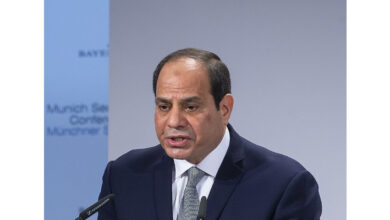“Hail Columbia” | Watts Up With That?

February 1, 2023 marked the 20th anniversary of the tragic loss of STS-107 Space Shuttle Columbia and her crew of seven brave astronauts.
STS-1, with Gemini 3 & 10 and Apollo 10 & 16 veteran John Young and Robert Crippen first lifted off from Launch Pad 39A on April 12, 1981 at 7:00:03 a.m. EST…
If the election of Ronald Reagan hadn’t already ended the 1970’s “malaise,” the launch and safe return of Columbia surely did.
During her nearly 22 years of service, Columbia completed 27 STS missions prior to her tragic loss on Feb. 1, 2003.
Jan 26, 2023
20 Years Ago: Remembering Columbia and Her Crew
The year 2003 was shaping up to be an ambitious one for NASA, with six space shuttle missions planned, five to continue construction of the ever-growing and permanently occupied International Space Station. The first flight of the year, STS-107 aboard NASA’s oldest orbiter Columbia, the first shuttle mission dedicated to microgravity research in nearly five years, would not travel to the space station but fly a 16-day solo mission. The seven-member crew would conduct many of the 80 planned U.S. and international experiments aboard a Spacehab Double Research Module in Columbia’s payload bay. The astronauts’ exceeded scientists’ expectations in terms of the science obtained during their 16 days in space. Tragically, the astronauts perished when Columbia broke apart during reentry on Feb. 1, 2003.
NASA first announced the STS-107 microgravity research mission, assigned to space shuttle Columbia, in March 1998, with a then-planned launch in May 2000, a date that began to slip almost immediately. In September 2000, NASA named the five-member science crew of Payload Commander Michael P. Anderson, Mission Specialists David M. Brown, Kalpana Chawla, and Laurel B. Clark, and Payload Specialist Ilan Ramon of the Israeli Space Agency, adding Commander Rick D. Husband and Pilot William C. “Willie” McCool three months later. Ramon’s participation grew out of a 1995 agreement between U.S. President Bill Clinton and Israeli Prime Minister Shimon Peres on space cooperation between the two nations. When assigned to the flight, the crew trained for an August 2001 launch, but various factors such as delays in Columbia’s refurbishment, technical issues affecting the space shuttle fleet, and competing priorities with a Hubble Space Telescope servicing mission and International Space Station assembly flights caused that date to slip to January 2003.
The STS-107 mission included a total of 80 experiments in a variety of research disciplines and carried out in different parts of the space shuttle. The astronauts worked directly with 32 payloads including 59 investigations in the Spacehab Research Double Module. These included nine commercial payloads involving 21 separate investigations, four payloads for the European Space Agency with 14 investigations, one investigation to mitigate risk for the International Space Station, and 18 payloads supporting 23 investigations for NASA in the fields of physical and biological sciences. Many of these experiments had application for future studies aboard the space station, prompting STS-107 Mission Scientist John B. Charles to refer to the mission’s research as doing “simulated space station science, although the science itself stands on its own right.” The Canadian Space Agency, the German Space Agency, the U.S. Air Force, and several universities also flew experiments in the Spacehab. Three experiments requiring exposure to open space flew attached to the top of the Spacehab module, while the Hitchhiker truss in the payload bay housed six experiments, including an Israeli investigation looking at Saharan dust distribution in the Mediterranean region using a multi-spectral camera.
Space shuttle Columbia began its 28th mission with a spectacular liftoff from Launch Pad 39A at NASA’s Kennedy Space Center (KSC) in Florida, at 10:39 am EST on Jan. 16, 2003. The launch appeared to go well and after eight and a half minutes, Columbia reached its planned orbit to begin the 16-day microgravity research mission. Beginning on their very first day in space, the seven-member crew split into two teams – Husband, Chawla, Clark, and Ramon made up the Red Team while McCool, Anderson, and Brown made up the Blue Team. For the duration of the mission, the teams worked opposite shifts, allowing for 16 days of continuous research operations. Brown busied himself with opening Columbia’s payload bay doors, while Anderson, Clark, and Ramon reconfigured the orbiter from a rocket to a spacecraft to support research, including activating the Spacehab research module. The Blue Team took the first sleep shift while the Red Team began to activate some of the experiments. For the next 15 days, Columbia’s crew worked tirelessly to complete the experiments, overcoming technical issues. Scientists on the ground were overjoyed at their performance and amazed at the greater than expected science return from the mission.
During routine analysis of launch films, engineers noted that at about 82 seconds into the flight, a piece of foam insulation released from the Shuttle’s External Tank (ET) appeared to strike Columbia’s left wing. On Jan. 23, the mission’s eighth day, Flight Director J. Steve Stich from Mission Control notified Husband and McCool of the foam strike via an email, including a video clip of the impact, but assured them that because the phenomenon had occurred on previous missions, it caused no concern for damage to the vehicle or for reentry. Husband informed the rest of the crew. However, engineers on the ground continued to assess the impact of the foam strike, requesting high-resolution imaging of the affected area to complete a more thorough analysis, but ultimately managers turned down the request. On Jan. 27, the STS-107 crew chatted via radio with the three Expedition 6 crew members aboard the International Space Station, in the third month of their planned five month mission.
On Jan. 28, Columbia’s crew members paid tribute to their fellow astronauts lost in the Challenger accident 17 years earlier and in the Apollo 1 launch pad fire on Jan. 27, 1967. Husband said, “It is today that we remember and honor the crews of Apollo 1 and Challenger. They made the ultimate sacrifice: giving their lives in service to their country and for all mankind. Their dedication and devotion to the exploration of space was an inspiration to each of us, and still motivates people around the world to achieve great things in service to others.”
The astronauts completed the last science sessions on Jan. 31 while Husband and McCool used a simulator to practice the entry and landing procedures and tested Columbia’s systems required for the return to Earth. The next morning, they closed the hatches to the Spacehab module, then closed the payload bay doors, with the entry team led by Flight Director Leroy E. Cain monitoring their activities from Mission Control. The astronauts donned their orange launch and entry suits and took their seats, with Husband, McCool, Chawla, and Clark on the flight deck and Brown, Anderson, and Ramon in the middeck. Husband and McCool oriented Columbia with its Orbital Maneuvering System engines pointing in the direction of flight, and after receiving the go for the deorbit burn from capsule communicator NASA astronaut Charles O. “Scorch” Hobaugh, fired the engines for two minutes and 38 seconds over the Indian Ocean. They reoriented Columbia with its nose facing forward and angled up at 40 degrees to face the heat of reentry, encountering the Earth’s atmosphere at 400,000 feet. To help slow the vehicle down, it flew a series of maneuvers to bleed off energy. Fifteen minutes after entry interface, flying over Texas at an altitude of 207,000 feet and 16 minutes from landing at KSC, Mission Control lost contact with Columbia and her crew.
Sixteen Minutes from Home
A Personal Remembrance
As far as Saturday mornings go, this one starts off pretty ordinary. My seven-year-old daughter Alex and I are at home; my wife Susan is at church for a meeting. Alex may disagree about ordinary, since instead of her usual cartoons or Disney videos, I have the family room TV tuned to the NASA channel to watch the space shuttle land in Florida this morning. Along with the launches that are far more spectacular, I make it a habit to watch these events live – as on this day, friends and colleagues are sometimes on board.
As we settle on the couch, the aroma of bacon and French toast lingers, evidence of the bribe to keep Alex’s complaining to a minimum. But I still get a few “Why do we have to watch this, it’s so boring!” and “Is it over yet?” sprinkled with the usual chatter of a seven-year-old as she reads her book. A welcome distraction from the NASA public affairs official announcing each passing milestone of the reentry. The newspaper rustles as I fold it up, I’ve finished reading the funnies, and I turn my attention to the TV as the time draws near. Touchdown is 16 minutes away.
Columbia’s crew was returning that morning from a 16-day science mission that had gone exceedingly well. In Mission Control, the scientists beamed at the results of the experiments, excited in their nerdy scientist way. The astronauts, confident as always, cavorting in weightlessness, making it all seem so easy. They thanked all the people who helped them prepare for the flight and looked forward to being home and sharing their adventure with everyone. Four days ago, they honored their fallen comrades, fellow astronauts lost in the Apollo fire and the Challenger accident, with a moment of silence.
Sure, there was talk of something that hit the wing during liftoff 16 days ago, but that was nothing to worry about, right? That happens all the time, and it always turns out ok, right? If it was serious, someone would be doing something about it. Right?? Of course! And besides, just a few days ago, Mission Control assured the astronauts there was “absolutely no concern for reentry.”
“Fourteen minutes to touchdown for Columbia,” says the public affairs announcer, breaking the silence. “Flight controllers continuing to standby to regain communications with the spacecraft.”
“Columbia, Houston. Comm check,” the capcom, or capsule communicator, calls to the crew, awaiting a response to the communications check. Silence. He tries again. Silence.
The first wispy tendrils of fear begin to tighten my insides. Something doesn’t feel right. They’ve been silent for more than two minutes. The usual communications blackout ended a while back. I now long for the usual boring technical chatter.
“Twelve and a half minutes to touchdown,” says the public affairs announcer.
“Columbia, Houston. Comm check.
“Columbia, Houston. Comm check.”
“Flight controllers are standing by for Columbia to move within range of the tracking station in Florida,” says public affairs. “And also waiting for tracking data from Florida.
“Ten and a half minutes to anticipated touchdown for Columbia.” The crescendo of fear is joined by confusion and a desperate need to know what’s happening, as more calls go unanswered.
“Eight minutes on the touchdown clock for Columbia.” Still no response from the crew.
“Six minutes to touchdown.” Ten minutes without a response, and more worrisome, radars in Florida see nothing where the shuttle should be. Mission Control declares a “contingency,” NASA-speak for “something’s gone seriously wrong.” They lock the doors, preserve all the data for the investigation to come. My insides are in a full-blown churn.
The countdown clock to touchdown reaches zero. They should have landed by now, announcing their arrival by the familiar double sonic boom. Searching the skies, searching in vain. Willing them to appear out of thin air into the empty silent Florida skies. But they’re late. They can’t be late. This is not right. I think of the families left waiting, wondering.
I turn to Alex, her chatter stops in mid-sentence. “Alex, this is very serious, we need to pay attention,” I say. “Something really bad has happened. I think my friends are in trouble, they may have died. I need to listen, OK?” She nods, her eyes big as saucers.
Frustrated with the lack of information on NASA TV, I switch to CNN and am inundated. My breath stops when they show the video from Dallas – one streak spreading into many, Columbia breaking up 200,000 feet over Texas. My brain toys with the idea that maybe they bailed out, but reality sinks in, I know they were too high for that. The grip of fear releases, unleashing a wave of tears, mercifully blurring the endless replays of that awful video.
I need to reach out, to call someone, to share the grief. Susan doesn’t answer. Of course, in a meeting, phone turned off. I try again anyway. Voice mail. I call coworkers. We share our feelings, something we don’t normally do. We ponder what to do, realize there is nothing. One I reach at the airport on his way to Japan – he hadn’t heard so I break the news to him. Then I feel bad about that. He’ll spend the next 14 hours in an airplane with no hope of updates. The rest of the day is a fog of swirling emotions, as I sit glued to the TV for news, unable to turn away.
Alex later told me that was the first time she’d ever seen me cry.
[…]
I personally heard the explosion (might not be the right word) in Dallas that Saturday morning, but didn’t know what it was until an hour or so later. The “bang” caused car alarms to go off and made swinging doors pop open.
The audacious rescue plan that might have saved space shuttle Columbia
The untold story of the rescue mission that could have been NASA’s finest hour.
LEE HUTCHINSON – 2/1/2023
February 1, 2023: One of the most tragic events in the history of space exploration is the loss of the space shuttle Columbia and all seven of her crew on February 1, 2003—a tragedy made worse because it didn’t have to happen. But just as it is human nature to look to the future and wonder what might be, so too is it in our nature to look at the past and wonder, “what if?” Today, on the twentieth anniversary of the event, Ars is re-publishing our detailed 2014 examination of the biggest Columbia “what if” of all: what if NASA had recognized the damage to the orbiter while the mission was still in progress? Could anything have been done to save the crew?
[…]




